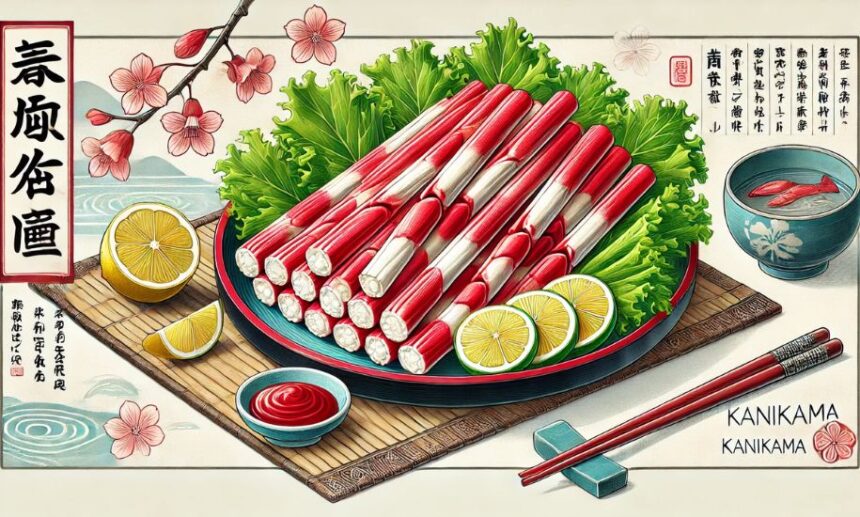Welcome to Market Blick! Today, we’re diving into the fascinating world of kanikama, a versatile and popular Japanese seafood product. Known by various names such as crab sticks, krab sticks, snow legs, imitation crab meat, or seafood sticks, kanikama has gained global recognition for its unique taste, texture, and affordability.
Derived from surimi, a paste made from pulverized white fish mixed with starch, kanikama is an affordable alternative to real crab meat. This article will explore its origins, production process, uses, and nutritional profile to give you a comprehensive understanding of this beloved culinary creation.
The Origins of Kanikama
Kanikama originated in Japan in the 1970s and has since become a staple ingredient in Japanese cuisine and beyond. The term “kanikama” literally translates to “crab taste,” reflecting its purpose as a crab meat substitute. Initially created to mimic the flavor and texture of crab meat, kanikama quickly gained popularity for its affordability and versatility.
While it started as a Japanese innovation, kanikama’s appeal spread globally, becoming a common ingredient in sushi, salads, soups, and other dishes worldwide. Its affordability and long shelf life make it a favorite for both home cooks and professional chefs.
How Kanikama Is Made
The production of kanikama begins with surimi, a finely ground paste made from white fish, such as pollock or hake. The process involves:
- Filleting and Washing: The fish is deboned and washed thoroughly to remove impurities and oils.
- Grinding: The fish is then ground into a smooth paste, creating surimi.
- Blending: Starch, egg whites, flavorings, and sometimes a small amount of real crab extract are added to enhance texture and flavor.
- Shaping and Coloring: The mixture is shaped into sticks or flakes and dyed with natural or artificial coloring to resemble real crab meat.
- Cooking and Packaging: The final product is cooked through steaming or baking and then vacuum-sealed for freshness.
Kanikama’s Culinary Uses
One of kanikama’s greatest strengths is its versatility in the kitchen. Here are some popular ways to use kanikama:
1. Sushi Rolls
Kanikama is a key ingredient in many sushi rolls, such as California rolls and kani sushi. Its mild, slightly sweet flavor pairs well with rice, seaweed, and other sushi ingredients.
2. Salads
Imitation crab meat adds a delightful seafood flavor to salads. Kani salad, for instance, combines shredded kanikama with mayonnaise, cucumber, and a touch of spice for a refreshing appetizer.
3. Soups and Stews
Kanikama can enhance the flavor and texture of soups and stews. It’s commonly used in miso soup, hot pots, and seafood chowders.
4. Snacks and Appetizers
Serve kanikama as a quick snack with dipping sauces or include it in appetizers like stuffed mushrooms or spring rolls.
5. Pasta and Stir-Fries
Kanikama can also be incorporated into pasta dishes and stir-fries, offering a seafood twist to traditional recipes.
Nutritional Profile of Kanikama
Kanikama is not only delicious but also offers a range of nutritional benefits. However, it’s essential to understand its composition to make informed dietary choices:
- Low in Calories: Kanikama is a low-calorie food, making it suitable for those watching their caloric intake.
- Moderate Protein Content: Although it’s not as protein-rich as real crab, it provides a decent amount of protein.
- Low Fat: Kanikama is low in fat, which makes it a heart-healthy choice.
- Contains Additives: Some varieties may contain added sugar, sodium, and artificial flavorings, so it’s important to check labels if you have dietary restrictions.
Kanikama vs. Real Crab: Key Differences
While kanikama is designed to imitate real crab meat, there are distinct differences:
- Flavor: Kanikama has a milder, sweeter taste compared to the briny, rich flavor of real crab.
- Texture: While kanikama mimics the flaky texture of crab, it’s slightly softer and more uniform.
- Cost: Kanikama is significantly cheaper, making it a budget-friendly alternative.
- Nutritional Value: Real crab is higher in protein and contains essential nutrients like omega-3 fatty acids, which are less prevalent in kanikama.
The Global Appeal of Kanikama
Kanikama’s affordability, convenience, and versatility have made it a global phenomenon. From the sushi bars of Tokyo to supermarket shelves in the United States and Europe, kanikama continues to be a popular choice for consumers seeking a seafood flavor at a fraction of the cost.
Its adaptability also means it can be tailored to different cuisines, making it a truly universal ingredient. Market Blick celebrates the diversity and accessibility of kanikama, highlighting its role in bridging culinary traditions worldwide.
Tips for Choosing and Storing Kanikama
To get the most out of kanikama, consider the following tips:
- Check the Ingredients: Look for brands with minimal additives and higher surimi content for better quality.
- Proper Storage: Store kanikama in the refrigerator and consume it before the expiration date.
- Freezing: If you don’t plan to use it immediately, kanikama can be frozen to extend its shelf life.
Conclusion
Kanikama, or imitation crab meat, is a remarkable product that combines tradition, innovation, and practicality. Its ability to mimic the flavor and texture of crab at a lower cost has made it a favorite ingredient in kitchens around the world. Market Blick appreciates the ingenuity behind kanikama and its role in bringing seafood flavors to a wider audience.
Whether you’re preparing sushi, a hearty soup, or a simple salad, kanikama offers endless possibilities. Embrace its versatility and enjoy exploring new ways to incorporate this delightful ingredient into your meals.







